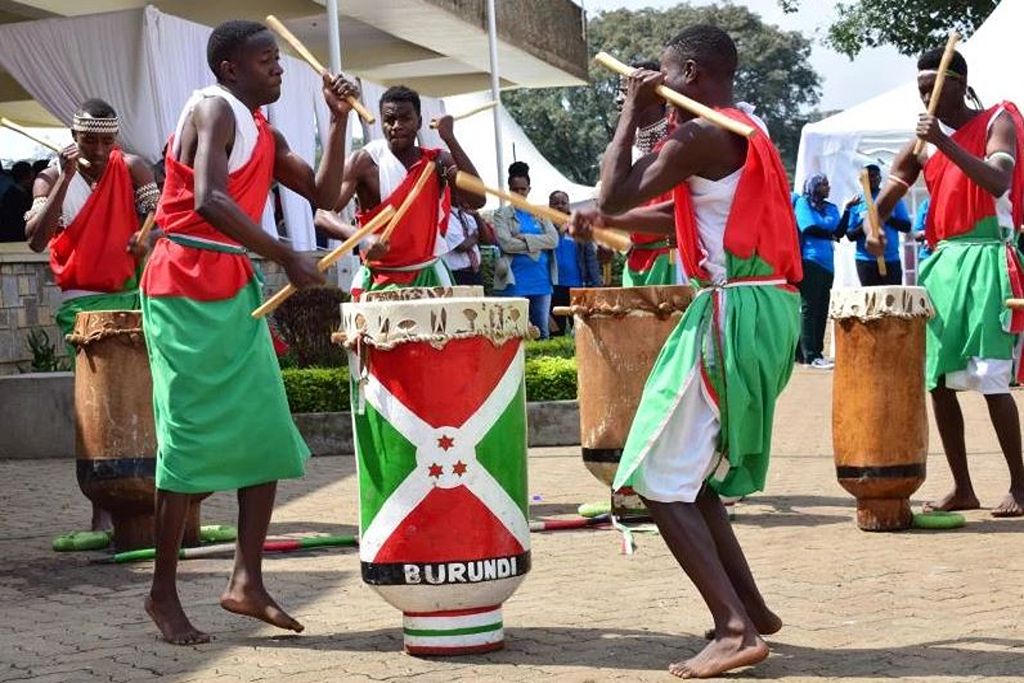BURUNDI
Burundi, officially known as the Republic of Burundi, is a landlocked country in East Africa. It is bordered by Rwanda to the north, Tanzania to the east and south, and the Democratic Republic of the Congo to the west. The southwestern border is adjacent to Lake Tanganyika.
Key Facts About Burundi:
- Capital: Gitega
- Largest City: Bujumbura
- Official Languages: Kirundi, French, English
- Population: Approximately 11.89 million (2021 estimate)
- Currency: Burundian franc (BIF)
- Government: Presidential republic
- Current President: Évariste Ndayishimiye
- Independence: July 1, 1962 (from Belgium)
Geography and Climate
Burundi has a diverse topography with mountains, plateaus, and plains. The country's climate is equatorial, with significant variations due to altitude. Burundi experiences two main rainy seasons, from February to May and from September to November.
Economy
Burundi's economy is predominantly agricultural, with more than 90% of the population engaged in subsistence farming. Coffee and tea are the main export crops. Despite its rich natural resources, Burundi is one of the world's poorest countries.
Culture
Burundi has a rich cultural heritage that includes traditional music, dance, and storytelling. The drumming tradition, especially the royal drum ensemble known as "Ingoma," is recognized by UNESCO as an Intangible Cultural Heritage of Humanity. Burundi's culture is also influenced by its ethnic groups, primarily the Hutu, Tutsi, and Twa.
Challenges
Burundi faces several challenges, including political instability, economic hardship, and social issues. Efforts to rebuild and develop the nation continue, with a focus on peacebuilding, economic development, and improving living conditions.
Tourism
Tourism in Burundi is still developing, with attractions that include natural parks, lakes, and cultural sites. Notable locations include Kibira National Park, Rusizi National Park, and the source of the Nile River. Lake Tanganyika offers opportunities for water sports and fishing.
Burundi is a country with a complex history and a resilient population. Despite facing numerous challenges, the people of Burundi continue to strive for a better future.

Burundi National Parks
1. Rusizi National Park, Burundi
- Location: Near Bujumbura, the capital city of Burundi.
- Facts: This park is known for its hippo population and diverse bird species. It's located along the Rusizi River, which forms the western border of the park.
- Lodges to Stay In: Safari Gate Hotel, Rusizi Tented Camp.
- Activities to Do: Bird watching, boat safaris, hippo and crocodile viewing, guided nature walks.
- More Details about Rusizi National Park
- Rusizi National Park, located in Burundi, is a haven for wildlife enthusiasts and nature lovers. The park is situated near the Rusizi River and covers a diverse landscape that includes wetlands, savannah, and dense forests. It is renowned for its rich biodiversity, hosting a variety of species such as hippos, crocodiles, and numerous bird species, making it a prime spot for bird watching. The park offers visitors a unique opportunity to experience the natural beauty and wildlife of Burundi, with guided tours available to explore its scenic trails and waterways.
2. Kibira National Park, Burundi
- Location: Northwestern Burundi, near the town of Kayanza.
- Facts: It covers approximately 400 square kilometers and is part of the large Congo-Nile divide forest. It is home to a variety of primate species and a rich array of flora and fauna.
- Lodges to Stay In: Kibira Park Hotel, Tanganyika Blue Bay Resort.
- Activities to Do: Hiking, bird watching, primate tracking, visiting tea plantations.
- More Details about Kibira National Park, Burundi
- Kibira National Park, located in northwestern Burundi, is a pristine and biodiverse wilderness area that covers around 400 square kilometers. The park is part of the vast Congo-Nile Divide forest region, which extends into neighboring Rwanda. Renowned for its lush montane rainforest, Kibira is home to a wide variety of flora and fauna, including numerous endemic species.
The park's diverse ecosystems support a rich array of wildlife, such as chimpanzees, black-and-white colobus monkeys, and numerous bird species, making it a haven for birdwatchers and wildlife enthusiasts. The park's dense forests and rolling hills offer excellent opportunities for hiking, birdwatching, and nature photography.
Kibira National Park also plays a crucial role in watershed protection, as it is the source of several rivers that are vital for the surrounding communities. Conservation efforts are ongoing to protect the park's unique biodiversity from threats such as deforestation and poaching.
Visitors to Kibira National Park can enjoy guided tours and educational programs that highlight the importance of conservation and the natural beauty of this remarkable region. The park is accessible from the town of Bujumbura, making it a convenient destination for eco-tourists and adventure seekers alike.
3. Ruvubu National Park, Burundi
- Location: Northeastern Burundi, along the Ruvubu River.
- Facts: This is the largest national park in Burundi, covering an area of about 508 square kilometers. It's known for its rich biodiversity, including several endangered species.
- Lodges to Stay In: Karera Beach Hotel, Ruvubu Guesthouse.
- Activities to Do: Game drives, bird watching, hiking, river excursions.
- More Details about Ruvubu National Park, Burundi
- Ruvubu National Park is the largest national park in Burundi, covering an area of approximately 508 square kilometers. Situated in the northeastern part of the country, the park is named after the Ruvubu River, which flows through its terrain. The park is renowned for its rich biodiversity, featuring a variety of habitats that include savannas, forests, and wetlands. Visitors to Ruvubu National Park can expect to see a wide range of wildlife, including elephants, hippos, buffaloes, and various species of antelope. The park is also home to numerous bird species, making it a popular destination for birdwatchers. Efforts are ongoing to preserve and protect the natural environment of Ruvubu National Park, ensuring that it remains a sanctuary for wildlife and a place of natural beauty for future generations.
4. Lake Tanganyika National Park, Burundi
- Location: Along the eastern shore of Lake Tanganyika.
- Facts: The park is renowned for its stunning landscapes, sandy beaches, and clear waters of Lake Tanganyika, the second deepest lake in the world.
- Lodges to Stay In: Bora Bora Beach Hotel, Lake Tanganyika Beach Resort.
- Activities to Do: Swimming, snorkeling, fishing, boat trips, beach relaxation.
Overview of Lake Tanganyika National Park in details
Lake Tanganyika National Park, located in Tanzania, is a breathtaking destination renowned for its stunning natural beauty and rich biodiversity. Stretching along the eastern shores of Lake Tanganyika, the park offers visitors an unparalleled experience with its pristine waters, lush landscapes, and diverse wildlife.
Key Highlights:
- Marine Life: Lake Tanganyika is one of the oldest and deepest freshwater lakes in the world, home to a unique array of aquatic species. The crystal-clear waters are ideal for snorkeling and diving, offering glimpses of colorful fish, including numerous endemic species.
- Wildlife: The park's terrestrial areas are teeming with wildlife, including elephants, chimpanzees, and a variety of bird species. The dense forests and grasslands provide a perfect habitat for these animals, making it a haven for wildlife enthusiasts and photographers.
- Scenic Beauty: The park's landscapes are incredibly picturesque, featuring rolling hills, verdant forests, and pristine beaches. The stunning sunsets over the lake create a magical ambiance, perfect for relaxation and contemplation.
- Cultural Experience: Visitors can also engage with the local communities around the park, learning about their traditional lifestyles and customs. The cultural interactions add a unique dimension to the visit, providing deeper insights into the region's heritage.
Activities:
- Snorkeling and Diving: Explore the underwater world of Lake Tanganyika, observing the vibrant marine life.
- Wildlife Safaris: Embark on guided tours to spot the diverse terrestrial wildlife.
- Bird Watching: Discover the rich avian life with numerous species to observe and photograph.
- Hiking and Nature Walks: Enjoy the scenic trails that offer stunning views and close encounters with nature.
- Cultural Tours: Visit nearby villages to experience the local culture and traditions.
Lake Tanganyika National Park is a must-visit destination for nature lovers, adventure seekers, and those looking to immerse themselves in the beauty of one of Africa's most remarkable natural wonders. Plan your visit today and embark on an unforgettable journey into the heart of Tanzania's wilderness.
Burundi, a small landlocked country in East Africa, experiences a tropical highland climate. Burundi's weather is marked by two main seasons: the dry season and the rainy season. The dry season in Burundi runs from June to September, bringing moderate temperatures and less humidity. Conversely, Burundi's rainy season, from October to May, is characterized by heavy rainfall and higher humidity levels.
Burundi's altitude plays a significant role in its climate variability. The central plateau of Burundi, with elevations ranging from 1,400 to 1,800 meters, tends to be cooler than the lower regions. In these highland areas of Burundi, temperatures can drop to around 10°C (50°F) at night, while daytime temperatures hover around 20°C (68°F) to 25°C (77°F).
In contrast, the lowlands of Burundi, particularly along the shores of Lake Tanganyika, experience warmer temperatures year-round. This region of Burundi enjoys temperatures ranging from 23°C (73°F) to 28°C (82°F). The lake's influence moderates the climate, making it a popular destination for tourists visiting Burundi.
Burundi's rainfall patterns are influenced by its geographical features and the Intertropical Convergence Zone (ITCZ). In the mountains of Burundi, rainfall can exceed 1,200 mm annually, while the lowlands receive around 800 mm. The diverse climate and weather conditions in Burundi contribute to its rich biodiversity and unique ecosystems.
In summary, Burundi's climate is characterized by a distinct seasonal cycle, influenced by altitude and geographical location. Whether exploring the highlands or the lowlands, visitors to Burundi can expect a variety of weather patterns that add to the country's natural charm.
